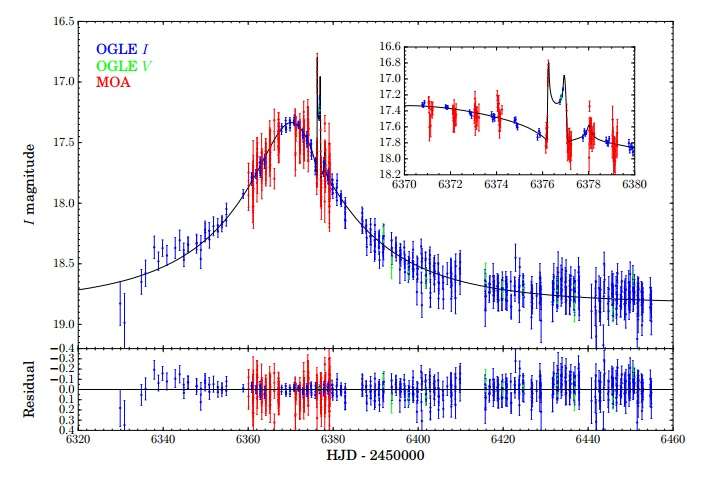May 8, 2017 report
Two new Saturn-mass exoplanets discovered

(Phys.org)—An international team of astronomers has detected two new giant alien worlds circling distant stars. The newly found planets are estimated to be as massive as Saturn and are orbiting M dwarfs beyond the snow line. The findings were presented May 2 in a paper published online on the arXiv pre-print server.
The planets were discovered by researchers working as part of the Optical Gravitational Lensing Experiment (OGLE) group and the Microlensing Observations in Astrophysics (MOA) collaboration. OGLE uses the 1.3-m Warsaw Telescope located at Las Campanas Observatory in Chile, while MOA utilizes the 1.8-m MOA-II telescope at the Mount John University Observatory, located in New Zealand. The main goal of these two microlensing surveys is to study the planet formation around late-type stars.
Gravitational microlensing is an invaluable method of detecting new extrasolar planets circling their parent stars relatively closely. This technique is sensitive to planets orbiting beyond the so-called "snow line" around relatively faint host stars like M dwarfs or brown dwarfs. It is a location in the proto-planetary disk where the water ice may condense and where gas giant planets are believed to be formed. Therefore, understanding the distribution of exoplanets in this region could offer important clues to how planets form.
Recently, OGLE and MOA scientists led by Przemek Mróz of the Warsaw University Observatory in Poland, have found planetary anomalies in two faint microlensing events designated OGLE-2013-BLG-0132 and OGLE-2013-BLG-1721.
"Both events showed clear deviations from the simple point-source point-lens model, caused by the presence of a second body with well-measured planet-to-host mass ratios of (5.15 ± 0.28) x 10-4 and (13.18 ± 0.72) x 10-4, respectively," the researchers wrote in the paper.
The newly discovered planets received designation OGLE-2013-BLG-0132b and OGLE-2013-BLG-1721b. Both planets likely belong to a group of sub-Jupiter-mass planets orbiting M dwarfs beyond the snow line distance.
According to the research, OGLE-2013-BLG-0132b has a mass of about 0.29 Jupiter masses and orbits its parent star at a distance of 3.6 AU. The planet's host is located about 12,700 light years away and has a mass of approximately 0.54 solar masses. With a mass of about 0.64 Jupiter masses, OGLE-2013-BLG-1721b is circling its host (0.46 solar masses) at a distance of 2.6 AU. This planetary system is located some 20,500 light years away from the Earth.
The researchers estimated the masses of the planets using the Bayesian analysis as both events were short and faint, which prevented them from measuring a reliable parallax signal.
"Both events were too short and too faint to measure a reliable parallax signal and hence the lens mass. We therefore used a Bayesian analysis to estimate masses of both planets," the paper reads.
The team noted that in order to uncover more properties of the two newly discovered planetary systems, follow-up high-resolution imaging observations should be conducted in the future. In particular, the Near InfRared Camera (NIRCam) on the James Webb Space Telescope (JWST) that will be launched into space in late 2018, could reveal important insights about these new Saturn-mass exoworlds.
More information: OGLE-2013-BLG-0132Lb and OGLE-2013-BLG-1721Lb: Two Saturn-mass Planets Discovered around M-dwarfs, arXiv:1705.01058 [astro-ph.EP] arxiv.org/abs/1705.01058
Abstract
We present the discovery of two planetary systems consisting of a Saturn-mass planet orbiting an M-dwarf, which were detected in faint microlensing events OGLE-2013-BLG-0132 and OGLE-2013-BLG-1721. The planetary anomalies were covered with high cadence by OGLE and MOA photometric surveys. The light curve modeling indicates that planet-host mass ratios are (5.15±0.28)×10−4 and (13.18±0.72)×10−4, respectively. Both events were too short and too faint to measure a reliable parallax signal and hence the lens mass. We therefore used a Bayesian analysis to estimate masses of both planets: 0.29+0.16−0.13 MJup (OGLE-2013-BLG-0132Lb) and 0.64+0.35−0.31 MJup (OGLE-2013-BLG-1721Lb). Thanks to a high relative proper motion, OGLE-2013-BLG-0132 is a promising candidate for the high-resolution imaging follow-up. Both planets belong to an increasing sample of sub-Jupiter-mass planets orbiting M-dwarfs beyond the snow line.
© 2017 Phys.org





















